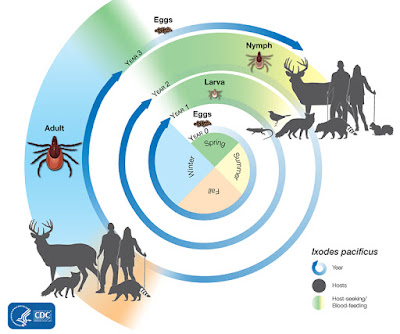Tickfest
For one thing, there are now lots more of them.
My go-to place for birdwatching is the Tavy estuary, accompanied by Zola (see pic), yet this beauty spot is now out of bounds. After finding Zola covered in several ticks after every walk there, I must save the joy of that place for mid-winter only.
After the long journey from where they land to their favoured locations on Zola’s bare skin around her eyes and mouth, they insert themselves for the long bloody feast. Thankfully she seems unbothered but they drive some dogs mad with itching.
The Ticks clearly know what they are doing and have evolved to do it well. They travel upwards till they hit bare skin, for a hairy dog that’s around the head, though anywhere they can get to skin will do.
They like humans too. While scratching an itch the other night I found one of the little critters happily dug in for the long haul. Nicky’s nursing skills and a Tom Tick Twister did the rest. I shall leave it to your imagination as to where it decided to stay, but its not the first time I have had a tick in my nether regions!
Their spread was recently confirmed by the experiences of moor loving friends, one of whom has to visit the doctor to have dozens of them removed after a camping trip on the moor.
Its clearly festival time for ticks!
Tick lifestyle
It all comes down to the ticks lifecycle. In a sentence this involves jumping from one animal to another, sucking blood at every turn, thus spreading infections between one host and another.
Rather like sharing needles with other species! Their amazing lifecycle is worth understanding.
From eggs, they hatch into larvae which latch onto small animals like mice and reptiles, feed till full, drop off, moult and become nymphs.
These too then find another host on whom to dine till full, drop off, moult and become adults.
Adults, being larger, can crawl up grass and lie there waiting for a larger animal to brush by. They latch on, feed again, drop off, mate with any males in the area, lay about 5000 eggs and die.
Off the cycle starts again with many many more larvae emerging to enjoy the warning weather and wait for a unwitting passer-by.
Simple, beautiful biology. Heres a picture of the egg to egg journey from the American Center of Disease Control.
This lifestyle also happens to be perfect for sharing any bacteria or viruses from the creatures on whom they dine, including us.
As with mosquitos, their mouthparts are like little hypodermic needles and so are the perfect disease generating vector. Don’t blame the ticks, all they want is lunch. The culprits are that unknown reservoir of pathogens which are a part of the natural world yet cause mayhem when they spillover into ours.
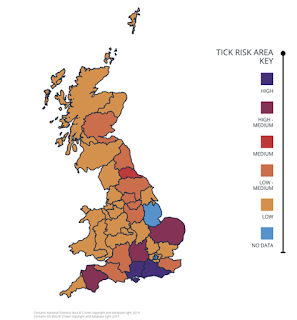 |
| Tick Prevalence |
Remind you of the origin of COVID19? Indeed.
Ticks travel well. They can hook onto migratory birds and beasts, travel on pets and traded animals and have thus spread around the world.
They are hardy too, able to survive cold and heat and even submersion in water for days and in between their feasts they use almost no energy. Like a spider that just waits for months for a meal, they can survive for very long quiet spells, just waiting.
They breed well too, each adult laying 5000 eggs many of which survive and begin their own parasitic lifestyle.
So what diseases do they bring?
Lyme disease.
While I did not have many consultations for ticks in my urban practice, the subject did come up as more people became aware that caution after a Tick bite is a good idea.
When I was diagnosed with MS, I thought I’d better not make a fool of myself by missing Lyme disease (whose later stages have many symptoms similar to those of MS), as I had been bitten by a quite a few ticks though never with a rash or consequent fever. All tests thankfully negative. Leaning more about Lyme disease was sobering.
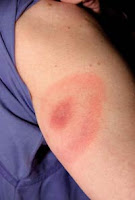 |
| If you see this, see a doctor |
Lyme disease is named after a town in the USA where is was first noticed as recently as 1975. It’s caused by Borrelia burgorferi, a bacterial fellow traveller with Ticks, and one of a class of bacteria called Spirochetes, so is distant cousin of Syphilis.
If a Tick is infected, and in some US states more than half of them are, then you may get infected after a Tick bite. The first stage of Lyme disease features a flu like illness and a rash which sometimes though not always, heralds the infection. This can appear from 3 days to THREE MONTHS after a tick bite. Even if you cant remember a tick bite, a rash like this means a trip to the GP.
Indeed any symptoms after a tick bite means a call to the Doctor. Further, because Ticks can bite, feed and depart without you even knowing it, a rash like this, or odd symptoms might be due to Lyme disease even if you can’t remember being bitten. If you live in an areas where Ticks are prevalent, this is important to bear in mind.
Like Syphilis, it causes a milder flu-like initial phase, then a secondary and final phase as it impacts around the body, This is thankfully rare, but shows the importance of early recognition and treatment after a Tick bite.
Treatment
It is treatable with antibiotics, and the earlier the treatment the better. A vaccine has been developed to which ran into problems typical of the difficulties of modern new vaccines development.
The vaccine, LYMErix, was
withdrawn in 2002 after a class lawsuit rendered the vaccine unprofitable. Th
e scientific consensus suggested that the vaccine was safe, with far more benefits than side effects, but the presence of some side effects and the medio-legal quagmire in the US means it is hard to see vaccine developers having another attempt. This represents the loss of a very useful method of managing Lyme’s disease.
 |
| UK Lyme disease cases 2001-17 |
It is now found in all US states and has travelled around the world, even to Antarctica. It now infects 300,000 people in the USA every year, is the most common vector borne disease in Europe and dare I say it, has rightly been called a pandemic.
Of course, the Tick just goes about its business of reproducing, they don’t choose which organisms join them on their journey.
So might it be interesting to look at what other diseases they bring with their dinner? I’m afraid so……
Other tick borne illnesses
Once again I get a feel for the incredible reservoir of microscopic life out there and our changing relationship with the natural world we are so changing.
Without going into excruciating detail of the individual illnesses the Ticks transmit, around the world, their fellow passengers cause:
- Rocky mountain fever
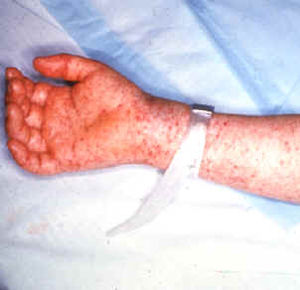 |
Rash of Rocky Mountain Fever
From Wikipaedia |
- Queensland tick typhus
- Finlanders Island spotted fever, (Australia)
- Ehrlichiosis
- Babesiosis which comes from protozoa.
- Powassan virus
- Crimean Congo Haemorrhagic fever
- Alpha-gal syndrome which leads to allergy and anaphylaxis to meat.
And in other animal hosts:
- Ghost moose with emaciated animals ill due to thousands of feeding Ticks
- Swine fever, which infects pigs
- Canine piroplasmosis, which infects dogs
For a recent review on tick borne diseases, click here, but for me, one other significant illness comes to mind:
Tick borne encephalitis
This is caused by the unimaginatively named Tick Borne encephalitis Virus (TBEV) and can cause significant neurological illness in humans with a mortality of 1-2%. It has been present in Eastern Europe since the 1930’s and has now arrived in the UK, having been found in Ticks in Norfolk, though has not directly infected humans in the UK, so far. It seems just a matter of time.
For those working in forests the risk is one case per 10,000 hours of woodland work. It is common enough in affected areas for science to have come to the rescue with a vaccine available to travellers to endemic areas and woodland workers.
So, what to do about ticks?
Don’t get bitten.
I can talk! I have had lots of visitations from Ticks, but now feel I will do better. Wearing long trousers in the woods helps; keeping away from areas known to be riddled with them in the warm seasons might be a good idea too.
Brush any off that might be climbing up your skin or clothes or on your pets.
If you do get bitten.
Be aware that you won’t notice the bite. When hidden from view they can feed for some time without you noticing their presence at all. Itching might give the game away, but I had a whopper on my back which felt like a skin polyp before my wife spotted it.
How do they manage to do this?
 Cleverly, they spray an anti-inflammatory onto the skin before hooking on, so you will not feel the bite. It means that they can bite, feed and drop off without you even knowing it.
Cleverly, they spray an anti-inflammatory onto the skin before hooking on, so you will not feel the bite. It means that they can bite, feed and drop off without you even knowing it.Without this, you would feel the bite and brush them off, and they would remain hungry and die out. That they have evolved this mechanism speaks of the wonder of evolution!
If it’s too late and you notice an embedded tick, you can remove then as described on the website of the excellent Lyme Disease Action group. The manufacturers also have a video showing exactly how it’s done. If you haven’t got one of these little tools, and live or visit tick infested areas, then get one.
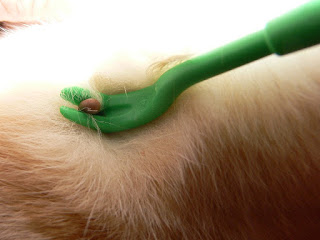 |
| Tom Tick Twister |
This is really important: if you get bitten and remove the tick, put it in a container, and keep in in the freezer for at least a few weeks. This means that if you are unlucky enough to get ill, then knowing the species of tick and its contents might be useful to know.
If you don’t get any symptoms then you can take part in Public Health Englands scheme for tick survelliance by sending the tick to them. Unfortunately, they don’t test for the pathogens the tick carries, but doing t
his can help them keep track on what is going on.
If you get ill after a tick bite.
Any rash, fatigue or cold or flu like symptoms after a Tick bite means a trip to the doctor to consider the need for treatment with antibiotics. There is a blood test which can diagnose the acute illness though treatment should be started immediately while the results are awaited if the rash is present, or if you feel unwell. There are also blood tests to discover if you have been infected in the past.
The Tick Pandemic.
I had intended this to be a light hearted, COVID free post, prompted by my latest brush with Ticks. Yet a closer look at the world of Ticks bring me right back to the modern world and the problems caused by our troubled relationship with nature.
There is undoubtedly a global pandemic of Ticks going on with the health impacts dependent on the pathogens they happen to bring with them in your particular area. They cross borders and spread globally, are increasing in number and carrying more pathogens.
It’s not hitting the headlines of course, but this in only due to its background spread and its carriage of many different pathogens, not just one.
Why is all this happening now?
1. Climate change means more Ticks are active for longer
Warmer shorter winters mean that the tick season is getting longer and their territory is expanding. This is a global phenomenon, with ticks and their passengers spreading, for example, from the US to Canada who have recently reported a 14 fold increase in cases of Lyme disease.
It is evident here too with ticks noticeable on Zola for most of the year, and spreading from Lopwell up the river Tavy to Denham Bridge and onto the moors. Further, they only lie dormant with subzero temperatures and without this they will be active thought the year even if the do really prefer the summer.
Warmer temperatures also mean Tics bite more aggressively.
This is climate change in action. No longer a warning – a consequence.
2. Species loss means more Ticks and more Tick related disease.
Species are disappearing at an alarming rate and this is changing the balance which kept Lyme disease quiet for humans till now.
High biodiversity reduces transmission to humans, but now with less species around, the Tick brings, and so any infections of mice and deer hosts are coming more and more into contact with humans. Suburbs are impinging on forests and deer, without any significant predators are increasing in numbers. Our huge number of pets also have a big role to play is the success of Ticks.
A Tick wont jump from dog to a human, at least not most of them, but they will drop off the dog, lay 5000 eggs somewhere very near and then start their life-cycle with all their bacteria and viruses on board.
More ticks, more mice, more deer and dogs, more human bites, more Lyme Disease and the rest. The romantic might see it as “nature fighting back”, but nature is indifferent.
The pattern is entirely logical and predictable.
3. Globalisation means a new Tick is coming to your area
Just like COVID19, all you need is one person, or pet, or animal to travel from one area to another with tick on board too, for a tick to spread globally. And that is what has happened in the USA.

The Asian Long-horned tick has been found on sheep in the USA and doing well for itself there. It brings with it many strange and exotic viruses and bacteria which have infected
livestock, and is known to carry pathogens causing an emerging deadly hemorrhagic fever.
So far no cases in the US, but is it just a matter of time?
It can reproduce without the inconvenience of mating, producing 2000 eggs containing clones of itself every six months. Thus it has rapidly spread across the USA. Watch this space!
Another example of this occurred in Mexico. In 2018 an outbreak of Rocky Mountain Fever caused by the bacteria Rickettsia Rickettsii delivered by the brown dog tick, led to 7,000 cases and hundreds of deaths. Thankfully, it can be treated with antibiotics.
4. Tick evolution- they are getting smarter.
The more ticks contact humans deer and dogs, the more those Ticks will reproduce. This creates an evolutionary pressure which means Ticks are coming far more into our lives. In the US, species have become more likely to attach themselves directly to humans and this can be seen as a marker for what is happening around the world.
This is not going to get any easier.
The final words
Just as I end this post, a tick drops off Zola and onto the floor. I now think of biosecurity. I crush the little critter between a sheet of paper with care not to contact any of its blood. Then into the bin and from then to its ultimate incineration in Plymouth. No 5000 eggs from that one!
Perhaps I should have worn gloves and eye protection? What bugs were in its blood? Would they be able to jump from human to human? Should I self-isolate? Notify Public Health?
Ring any bells??
The story of Ticks mirrors the story of Sars-Cov2-19. Instead of bats, think mice and deer and instead of pangolins (or some other vector) spreading the disease to humans, think of Ticks doing the dirty work.
Globalisation, habitat destruction and climate change are changing the world. The chaos of COVID19 shows how unprepared we are for biological threats, Tick borne diseases do too.
Yet, COVID19 might well go away or become a part of life, like flu. Ticks however will not. Even if richer nations are able to treat some (though not all) of the tick borne illnesses with antibiotics or prevent them with vaccination (occasionally) we are behind the curve when it comes to rapid diagnosis and treatment or Tick borne illnesses.
All around us species from the tiniest viruses to bacteria, and bats are evolving fast and we are not only driving this evolution but barely keeping up with what is going on. We are only now becoming aware of how little we know about our global ecology which gives us our life and which can also take it away.
These manifold, incredible creatures are not moving into our habitat, we are moving into theirs.
The warnings are over, the consequences are here.
We need to adapt and adapt fast.
Want to know more?
There is an excellent series written by
Alex Bhattacharji which will take you further into the world of Ticks and many of the links in this post will also help you expand your understanding.
That is if, like me, you are hooked!
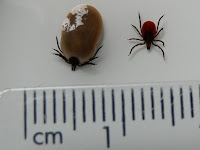




 Cleverly, they spray an anti-inflammatory onto the skin before hooking on, so you will not feel the bite. It means that they can bite, feed and drop off without you even knowing it.
Cleverly, they spray an anti-inflammatory onto the skin before hooking on, so you will not feel the bite. It means that they can bite, feed and drop off without you even knowing it.


